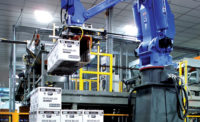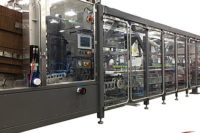Automation boosts stacking and loading capabilities to facilitate packaging tasks, reduce labor and speed up production. Equipment must be flexible, in order run a variety of package sizes, shapes and materials.
Stackers and loaders are an essential part of the warehousing and distribution chain. Today, there are more automated systems available to facilitate that link in the manufacturing chain. Automatic pallet dispensing is now part of stacking and feeding lines, resulting in more automation and less manual labor. For bakeries and snack food plants, these capabilities are essential to meeting their need for increased flexibility in packaging operations.
When it comes to packaging functionality, bakers and snack producers are seeking more flexible machines to run a variety of package sizes, shapes and materials. They are concerned about rising labor costs, which prompts them to look more closely at automation and robotic opportunities as a means of finding a relatively quick return on investment.
“According to a recent study by PMMI, the Association for Packaging and Processing Technologies, Reston, Va., about bakery and snack food packaging, manufacturers are asking for reduced case counts and more variety packs,” says John Kalkowski, director of marketing, Delkor Systems Inc., St. Paul, Minn. “In some cases, big-box retailers also are looking for shelf-ready packaging. It all depends on the merchandising channel. More of these products are being sold in convenience stores, where smaller, grab-and-go packaging is in demand.”
Among Delkor’s equipment innovations that improve stacking and loading is the C1 1400 Robotic Loader, which allows maximum production efficiency when loading flowrapped snack bars into tri-seal cartons. This compact machine is capable of loading 400 bars per minute, with multiple bars per pick, into cartons of single or multiple layers, according to Kalkowski.
The robot cell incorporates an articulating end-of-arm tool designed to gently yet accurately control the bars during loading. Cartons are accurately indexed into the cell and positioned for loading via servo-driven side belts. The walk-in frame design features full-length doors, which provide easy access for housekeeping. Sanitary design is considered throughout, incorporating a stainless-steel frame and use of food-grade materials on all food-contact surfaces.
“The fast and easy product changeover for a wide range of carton sizes and bar lengths is completely tool-less and it can be performed in less than five minutes without using change parts,” Kalkowski notes.
Bakers and snack food producers are looking to use packaging equipment for multiple products, so that production lines can be condensed, according to Matt Garcia, product line manager, robotics, at Thiele Technologies, Minneapolis. “Flexible automation (robotics) is the key to handling multiple package configurations along with minimizing changeover times,” he notes. “Less time in changeover means more time in production and higher output.”
Thiele Technologies offers Delta-style robots that perform accurate loading of product at speeds of more than 100 picks per minute. “New designs in robots and robot end effectors allow the machinery to be more sanitary as well as make changeover easier from one configuration to the next,” Garcia explains. “In some cases, the tooling does not have to change at all to handle more than one product. In addition, the use of vacuum technology yields the most versatile type of tooling.”
In conjunction with robotics, vision systems are improving rapidly, which removes complicated infeed systems to orient product for picking, Garcia says. “Vision systems integrated with robotics allow systems to adapt to random orientation of product without having to pre-stage or arrange it into a final pick configuration,” he adds.
Space premiums
Many bakers and snack food producers find storage space to be at a premium, says Cory Hypes, executive vice president, Power Automation Systems, Lathrop, Calif. “The bakery/snack food industry continues to grow at a faster pace than other food categories, yet the majority of existing facilities are unable to accommodate the growth of inventory,” he says. “Thus, they require facility expansion, third-party warehousing or new technologies to maximize the utilization of the existing facility.”
Power Automation Systems’ automated and semi-automated solutions are suitable for food manufacturers with a need for storing and warehousing stock-keeping units (SKUs) and high-quantity products. The company’s PowerStor is a fully automated, scalable robotic cart and lift-based system run by PASWare software. The system operates independently or can be customized to integrate with a baker’s or snack producer’s own warehouse-management system.
“PowerStor can operate in coolers and freezers down to subzero temperatures, which saves energy and increases worker productivity in a warehouse,” says Hypes. “One of PowerStor’s key benefits is that it increases storage density in an existing warehouse—right up to the roofline if necessary—enabling customers to eliminate outside storage and enhancing their manufacturing capabilities. In addition, it facilitates food tracking.”
Another facility challenge that bakers and snack producers often face is available floor space that’s not always optimal or connected.
Robotic designs can help reduce the need for floorspace, provide flexible solutions and more easily accommodate additional modules or robots for increased production, according to Barry Rinaldi, director of business development, at Schneider Packaging Equipment Co. Inc., Beaverton, N.Y. “To meet this challenge, Schneider can supply case and carton erecting equipment, sealing machines, robotic palletizing systems, labelers, verification, stretch-wrapping and quality control sytems (x-ray, metal detection, checkweighers) for fully integrated end-of-line solutions, bringing primary packaged product right to the truck or warehouse,” he says.
Schneider recently introduced ProAdjust, a scalable automatic setup and adjustment solution for machinery. Once ProAdjust is installed on new or existing machines, it uses a power pack and “handshake” interface to the machine controls to auto-adjust changeover adjustment points. “This essentially automates any equipment used in stacking and loading and eliminates manual adjustments,” says Rinaldi.
The Schneider robotic vertical case loader (RVCL) uses Delta robots and vision to locate, inspect, orient and nest product for high-speed top carton or case loading. The system reportedly is capable of loading standard regular-slotted (RSC) corrugated cases, half-slotted (HSC) cases, top-loading cartons and display trays. Products can also be loaded horizontally for bulk packing or vertically for high-impact point of sale display trays.
Special considerations
Stacking and loading equipment manufacturers also face special challenges when it comes to designing systems for bakers and snack producers. “Bakery and snack foods are usually either soft or very brittle, and they are frequently packed in bags or flexible packaging,” explains Kalkowski. “This type of primary packaging allows the product to be easily seen and does a good job of protecting freshness. But it does place special demands on loading the product into secondary packaging without crushing or damaging the food. That is a major reason why robotics are becoming increasingly important in secondary packaging.”
The demand for shelf-ready presentation is changing the way products are packaged, experts agree. “Retailers want the product protected during transit, yet also want to have it easily displayed once it reaches the store,” says Garcia. “This drives the need for equipment other than the typical RSC case erector. This trend is driving stacking and loading equipment innovation.”
Consumers continue to demand more variety in product size and nutritional value, but they’re also are conscious of brand and price. This presents a challenge for bakers and snack producers that gain cost benefits from long production runs and are hit with higher ingredients costs. “These pressures are pushing the cost-saving focus on operations, overhead and transportation,” Hypes sums up. “We foresee great potential cost savings via total warehouse automation of existing facilities, which will further reduce labor, energy and space costs.”











